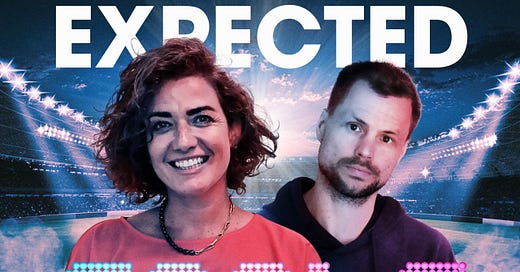Expected Goals; YouTube v OTT; Did someone forget marketing; When everything's a scroll; What Nikki Doucet just said; Platform as Enemy; Relatable stars v Mount Rushmore stars
Overthinking the sports business, for money
UP15 - USE THE CODE TO GET 15% OFF LEADERS WEEK LONDON
Leaders in Sport connects the most influential people and the most powerful ideas in global sport to catalyse discussion, and drive the industry forward. Through a series of global summits in North America, Europe, Asia and the Middle East, invitation-only memberships and long form content, Leaders in Sport provides professional executives, both on and off the field, with access to a community of peers to share best practice and trends that are shaping the future of sport.
Their flagship event, Leaders Week London, returns from 14 to 17 October, with The Summit taking place at Twickenham Stadium hosting the most senior executives from over 40 countries, including over 100 brands.
We'll be there, and you should join us. Visit leadersinsport.com/UP for more information and use UP15 for a 15% discount on your Summit passes.
NEW - We’re changing the conversation around the business of women’s football
Women’s professional football is a revealingly divisive topic.
If you’re not careful, you can be seduced in to framing it as a boring binary culture war in which you’re encouraged to take sides, between cheerleading and condescension.
So, what if we moved beyond ‘for or against’, and into more interesting territory?
That’s the brief of Expected Goals, our new podcast and event platform fronted by Maggie Murphy and Matt Cutler.
I’m thrilled with the casting. Matt is a really good journalist who’s been on the inside at Two Circles and now leads our Unofficial Partner Productions output.
And Maggie brings the insight and political understanding of someone who has been in the rooms where it happened.
As CEO of Lewes FC she was witness to the turbulence and excitement of the last five years, as the league architecture was constructed, and decisions were made that will shape the next decade of women’s football.
Have you run a football club that is the target for acquisition by Mercury13?
No, me neither.
Have you wrestled with the day to day challenge of managing the myriad constituencies of a professional football club, from fans and players to sponsors, media and governing bodies?
Nope.
And I can’t wait to hear how Maggie and Matt tackle the blizzard of questions, issues and challenges facing the game.
They came on to Unofficial Partner to talk about it, and you can hear that podcast tomorrow.
Then, they are off in the wild, as Expected Goals builds its own tribe on its own channels and on its own terms.
The first episode drops next Wednesday.
Get ready for something different. I know they’re waiting to hear from you.
Here’s a clip from tomorrow’s launch pod, on why we’re doing it.
Did you hear what Nikki Doucet just said?
Women’s Professional Leagues CEO Nikki Doucet was on R4's Today programme on Monday morning.
And I suspect that what she said will have far reaching implications beyond women’s football.
She was there to plug the Barclays WSL re-up - 3yrs @ £15mpa - which is great and all that, but that wasn't it.
She referenced the past match weekend, the first of the WSL season, which marks the initial test of a new media strategy, which shifted some of the WSL’s match inventory from owned and operated (FA Player) to YouTube. Across the top two leagues, (WSL and WC) Sky has 44 games, BBC has 22 and the remaining 70 which would have been on FA Player will be streamed on YouTube.
The numbers (always wrong etc) tell the story: historically, the best ever recorded audience for a WSL match on the FA Player was 78,000.
Compare that to last weekend: one game attracted 200,000 on YouTube.
London City Lionesses, the Championship club bought by Michele Kang, had a 50,000 audience for first game v Newcastle United.
These numbers are strategically useful for Nikki Doucet and the team at WPL, which is currently in the market place for a new broadcast deal.
But still…it’s tempting to use those numbers to ask a more universal question.
The OTT v YouTube binary
Fish where the fish are.
That's something people say at this point, isn't it.
YouTube is an audience monster so why fight it?
Why bother going to the cost and hassle of building a single sport D2C media platform when the people you want to label as fans are happily scrolling through everything they could ever want - clips, highlights shows, live and long form stuff - all delivered seamlessly whatever the device.
Like you, I’ve heard the arguments. Many, many times.
And my current position is that the value of OTT has been oversold.
Platform as Enemy
To create demand it’s been necessary to position YouTube in particular as the enemy of sports rights owners - OUR audience is on THEIR platforms, if only we could build our own walled garden we could prize them away and monetise our own fans in our own ecosystem.
This was an easy story to tell, because there's an audience that wants to hear it.
Who doesn't love blaming someone else for our own shortcomings, particularly if the enemy in question is a massive global, tax avoiding parasite.
You used to hear the anti-YT position articulated quite regularly, it moved from private chat to conference and podcast fodder.
Over time it morphed in to received wisdom.
But, today it feels like that argument has shifted, from the centre of sports industry opinion to the extremes.
Why?
First, the sort of numbers Nikki Doucet referenced above.
Second, YouTube has been on a charm offensive, seeking to build bridges with sports rights owners and framing the relationship in partnership terms, boosting their content and helping with discoverability.
Thirdly, the difficult reality of building a sports specific walled garden is becoming clear.
The problem is not one of technology.
If you want a TV station you can have one, like tomorrow.
Go to Sportel, you can't move for OTT vendors of all shapes and sizes.
Take your pick. The pipes await your content.
When everything’s a scroll
Whatever your pipe of choice - OTT or YouTube - you’re still left with the main job, which is marketing.
Quite often this got forgotten in the rush to build and they will come.
I sometimes ask CEOs who is their most valuable hire. The answers can be revealing, and have changed over time, from digital to content to data and back again.
They don’t often reference marketing.
Perhaps because the reputation of marketing has been tarnished, as everyone claims that they can do it, assuming they can just lay it on top of the thing they're really selling.
That’s an expensive mistake.
Proper marketing, and by that I mean a strategic understanding of audience and brand, is actually quite rare.
But without it, you’re just another clip to scroll past.
(Btw, FOMO alert: There was a spectacular thread on the UP WhatsApp Group this week, covering this topic).
Then throw in the power of the star
Thanks to Finn Bradshaw for pointing me to this article on SBJ:
WNBA’s average game viewership hit 24-year high in 2024
The WNBA averaged 657,000 viewers for the historic 2024 regular season, its best mark in 24 years and fueled by huge numbers for Caitlin Clark’s rookie season with the Indiana Fever.
A record 22 games reached 1 million viewers across the league’s Nielsen-rated media partners (ABC, ESPN, ESPN2, ION, CBS and NBA TV). The prior record was 15 games for a season in 1998. Clark played in 19 of those games that drew over 1 million viewers (and that doesn’t count the WNBA All-Star Game and WNBA Draft, which also set records this season).
On the surface, the news is very good.
As ever though, the nuance is where the interesting bit is.
There’s the vulnerability of the event rights owner to the power of the individual.
As Finn suggests: A figure to keep watching is the gap between Caitlin Clark games and other teams. Fever games averaged 1.19 million viewers this regular season, 199% better than 394,000 for other games.
The impact of Clark on the WNBA is pretty extraordinary.
It’s not going too far to make a Tiger Woods and PGA TOUR comparison from two decades ago.
Two builds.
What is the nature of athlete brands now, compared to that previous Tiger era?
Brand Tiger was a classic marketing construct, built on Nike TV and billboard ad spots. Like Beckham and Kate Moss from that era, the magic started to dissipate the further down from Mount Rushmore they travelled. We didn’t engage with them, we were in awe of them.
Is that type of distance possible today?
One thought is no, today’s stars are expected to be engaging across all platforms, seeking to appear relatable.
But, what happens when everyone does that?
Personally, I’d welcome a return to aloof and untouchable stars, the Hollywood school, who’d treat me with the contempt I deserve if I was ever to approach them, digitally or IRL.
Welcome to our new listeners
Thanks for reading.
Share this newsletter with your friends and family.
And finally…
Now click the Fucking Like Button, I Mean How Fucking Hard Can It Fucking Be????
It’s the heart shaped thing below, you fucking bell end. It’s the lowest form of human-to-internet engagement and for reasons we don’t quite understand helps us appear more popular with people who don’t yet receive the newsletter, most of whom are of no value in and of themselves, but who collectively add to the story that this newsletter is popular among a group we’ve started to call industry insiders.
We’re grateful for your help in this matter.







Great column, guys. WNBA data next year will be more interesting: Novelty of year 1 will be over + a couple of other big collegiate stars with huge social followings (Paige Bueckers and Juju Watkins) will have had an NCAA tournament spotlight onramp for their own debuts in the WNBA next season. Will be more indicative of whether we are riding a larger waive or whether this is a Tiger phenomenon.
Don't forget marketing! It's the most important position that so many CEOs don't think they really need. @unofficialpartner